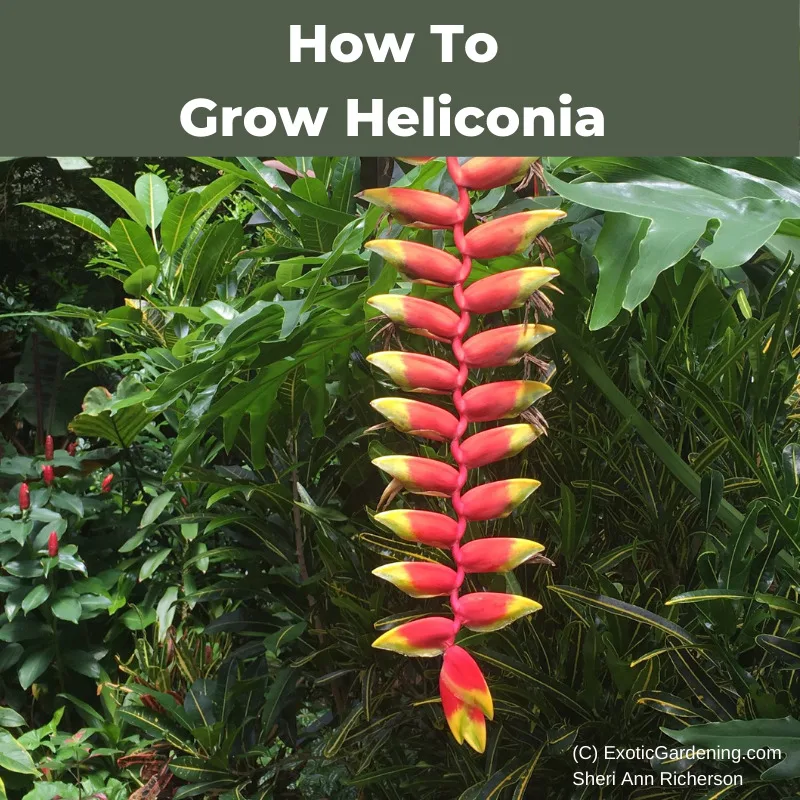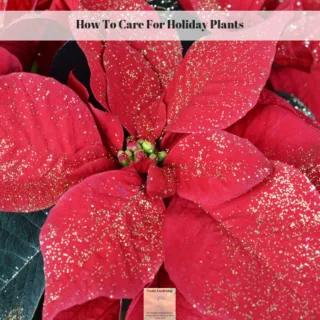Many people want to learn how to grow Heliconia simply because they are blown away by the colorful bracts the plant produces.
This is a fascinating plant that can grow indoors but many people are not aware of that because these plants are not readily available.
As with all tropical plants there are small varieties and larger ones that won't thrive indoors unless you have a very tall ceiling!
This article is going to help you understand their cultural needs so you can successfully grow Heliconia.

Description Of A Heliconia
The Heliconia consists of over one hundred species of plants native to tropical America.
Their native growth habit closely resembles that of the Banana or Canna, which is not surprising considering that Heliconias are a member of the Banana family.
The smooth, colorfully-veined leaves and striking long-lasting inflorescences are one of the main attractions of this species.
The inflorescences can either face upward or arch downward, and are commonly found in color combinations of yellow, orange, red and green.
The inflorescence is composed of triangular bracts in two ranks thus causing it to sometimes be referred to as a Lobster Claw.
The brightly colored bracts, which vary in length from a few inches to several feet, are not the true flowers of this plant though.
You will see those peeping out from the bracts.
They prefer to grow in large clumps and have extremely large leaves which is one reason why many people don't consider growing them indoors, but it can be done.
Light And Humidity Requirements For Heliconia
The Heliconia prefers bright, indirect light and high humidity.
Plant them in a large pot with plenty of space to grow in colder climates and place the pot on a humidity tray.
They seem to grow rapidly given the proper conditions and are easily divided by their rhizomes.
In warmer climates, go ahead and plant them directly in the ground.

Learn How To Grow Heliconia In The Right Soil Conditions
Learning how to grow heliconia is a bit tricky as the soil must remain moist even during their dormant period.
Heliconia prefer soil that is slightly acidic.
When they are grown in alkaline soil or soil that is not acidic enough, the leaves turn yellow or even white.
This is a sign of iron deficiency and needs to be addressed.
The soil needs to drain well but it must be able to retain moisture.
Heliconia do not like to dry out and from my experience allowing the soil to dry too much does kill them.
They also prefer soil that is fertile, but given the size of the leaves and the large flowers that is no surprise.
When flowers or leaves begin to die, go ahead and remove them.
Watch Out For Marasmius Disease
Once you have decided to grow Heliconias, you should be aware of a fungus that plagues Heliconias from the genus Marasmius, which will cause the rhizome to rot.
The symptoms of Maramius infection are a brown, dry rot of the rhizomes or the underground stems.
If the rhizome is older, they will be fibrous and easily fall apart.
The younger sections of the rhizomes that are affected will have soft brown rotten spots.
Sometimes it will be necessary to cut the rhizome open before you will be able to observe this.
An easy way to observe evidence of this fungus on rotted plants will be a white threadlike growth or the appearance of small mushrooms.
Brown Sheath Rot Is Another Heliconia Disease To Watch For
Brown sheath rot can also occur, and the infected plants will fail to grow and thrive as if they were suffering from a nutritional deficiency.
The best way to remedy this problem is to completely destroy infected plants and rhizomes.
This genus is easily spread from plant to plant and no known treatment, including heat, has been found to be effective at this time.
Not only are heliconias at risk for this disease, but also affected are gingers and bananas.
Do not put the infected parts into your compost bin either, as this will only spread the problem.
Learn How To Grow Heliconia And You're Sure To Love Them
These are beautiful plants to grow to brighten up your garden and home, and do not overlook them just because they may seem difficult.
As with every other plant, they can be infected.
As with every other plant proper care can be the greatest assest in keeping your Heliconia healthy and thriving.
Flowering Tropical Plants
How To Grow Tacca To Be A Successful Bloomer
The black flowers intrigued me, but the bat plant comes in many colors - brown, white and even green! Learn how to grow tacca from seed to bloom!
Amorphophallus Titanium: Life Cycle And Facts About The Corpse Flower
Learn about the life cycle of the Amorphophallus titanium as well as how to propagate it and some fun facts about this unique corpse flower.
Introducing Brugmansia: A Superior, Fragrant, Nocturnal Plant
Brugmansia trees are highly fragrant, night blooming plants with trumpet shaped flowers. Learn how to care for your brugmansia.
How To Care For Holiday Plants
Have you ever wondered how to care for holiday plants such as the Poinsettia or the Christmas Cactus? If so, then check out this holiday plant care guide
Zantedeschia aethiopica Green Goddess
Learn how easy it is to grow Zantedeschia althiopica Green Goddess from seed by using the damp paper towel method plus seed to bloom time.
Plumeria: The Lei Flower Is A Fragrant, Easy To Grow Houseplant
Learn how to care for your Plumeria in ground and in containers. Because of the winter dormancy period it is ideal for summer containers.
Growing Tropical Plants
The key to successfully growing tropical plants is learning about them. Growing tropical plants is easy once you know their basic needs.
7 Sure Fire, Proven Steps For Successful Orchid Care
Successful orchid care is pretty easy once you understand the seven basic steps the plant needs to thrive in your home environment.
How To Grow Enormous Tropical Bulbs In Containers
Learn how to successfully grow tropical bulbs in containers. Regardless of where you live, there are reasons to grow in containers.
Easy Exotic Houseplants: Tropicals That Thrive Indoors in Containers
Tropical plants are the most beautiful, easy to grow indoor houseplants. Start growing exotic houseplants today that fruit and flower!
Coral Vine (Antigonon leptopus): A Beautiful Yet Invasive Climbing Vine
Explore the allure and challenges of Antigonon leptopus, a captivating climbing vine, and its impact on local ecosystems.
Suggested Reading: Two Great Books On Tropical Ornamentals
Learn about two books on tropical ornamentals. Breeding Ornamental Plants and Tropical Ornamentals are a must read for those who love plants.
How To Grow Beautiful, Delicate Tibouchina
Tibouchina are beautiful but delicate plants with gorgeous purple flowers and a velvet like foliage. They can be bushes or vines.
How To Grow Mallows
Learn how to grow mallows, a Malvaceae family which includes some of the most popular plants for the home garden, Hibiscus.
Ophrys
Ophrys are a rare group of terrestrial Orchids that grow in the wild and look like insects, especially bees, hence their common name.
Flowering Trees For Fragrance And Beauty
Flowering trees add beauty and fragrance to the garden. There are ones for tropical climates, cold climates and even indoor gardens.
Expert Advice On How To Grow Beautiful Allamandas
Allamandas come in a range of colors, are easy to grow and do well in containers. They also overwinter well indoors in cold climates.
Expert Advice On How To Grow Oleanders
Learn how to grow Oleanders as well as propagation methods. Learn about the toxicity of this plant as well.
Rafflesia Arnoldii
Rafflesia arnoldii produces the largest flower in the world yet this colorful, but strange plant is rare and grows on the rainforest floor.
Tropical Plants In Cold Climates: Overwinter Tropical Plants Or Start Over Each Year From Seed
Tropical plants grown in cold climates look great during the summer outside but many make great houseplants in the winter.
Celebrate Halloween With Night Blooming Plants
A cool way to decorate and celebrate Halloween is with night blooming plants! Create a spooky garden that glows in the dark this year!
How To Grow Tropical Plants
Growing tropical plants - also known as houseplants - indoors is fun and enjoyable plus many of them clean the indoor of pollutants.
It is easy to grow exotic looking plants that produce tropical fruit and colorful flowers in a pot in your living room or office.
Many of these plants are easy to start from seed and I share with you five plants that I recommend for indoor growing.
I also share with you why growing your own tropical fruit saves money.
In this video you will learn:
How to bring tropical plants indoors at the end of summer
How to grow tropical plants indoors
How to protect and overwinter tropical plants outdoors in cold climates
How to propagate tropical plants
How to water tropcial plants
How to grow topical plants in a greenhouse

























